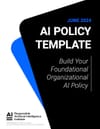📘 What’s Covered
The document provides a ready-to-adapt template for organizations aiming to implement a foundational and credible AI policy. Structured around a full AI management system, the template draws heavily from ISO/IEC 42001 and the NIST AI Risk Management Framework (RMF), and integrates terminology from the EU AI Act and U.S. Executive Order on AI.
Core Sections:
- Purpose and Scope: Introduces a flexible definition of AI, AI systems, and models. Suggests tailoring based on business use and jurisdiction.
- AI Principles: Anchored in trustworthiness (e.g., safety, privacy, fairness, accountability), and aligns closely with NIST AI RMF traits. Emphasizes human oversight, ethics, and continuous learning.
- Objectives and Strategy: Encourages documenting specific AI goals, mapping strategic priorities, and addressing unique organizational constraints—whether buying, building, or selling AI.
- Governance: Outlines roles for a Steering Committee and Operational Committee. Covers escalation processes, communication mechanisms, and decision gatekeeping at lifecycle milestones.
- Data and Risk Management: Exceptionally detailed. Includes templates for data inventory, quality, retention, consent, and versioning. Risk sections provide robust structures for impact assessments, risk triage, and contingency planning.
- Project, Workforce, and Stakeholder Management: Offers lifecycle phase-specific documentation and promotes DEI, responsible procurement, and internal alignment.
- Regulatory Compliance: Promotes proactive compliance tracking, documentation mapping, and system-level audit readiness.
- Procurement: Differentiates between “built” and “bought” AI. Introduces responsible supplier assessments, maturity thresholds, and data disclosure requirements.
💡 Why it matters?
This isn’t a theoretical policy draft—it’s a practical scaffolding designed for teams building or operationalizing a responsible AI program. It enables cross-functional collaboration across legal, compliance, engineering, and executive teams. Most importantly, it anticipates the global regulatory shift and creates pathways for organizations to align with ISO 42001 and incoming AI legislation (like the EU AI Act). A perfect starting point if you’re formalizing or reviewing your AI governance baseline.
🧱 What’s Missing
The template is extremely detailed but also complex—over 40 dense pages. Smaller or early-stage teams might find it overwhelming without guidance or a scaled-down version. It also assumes a relatively high level of organizational AI maturity and budget capacity. While adaptable, it could benefit from:
- Example case studies or sample entries for inventories and assessments.
- Pre-filled policy variants for different sectors (e.g., healthcare, finance).
- Visual lifecycle diagrams to reduce cognitive load.
🎯 Best For
- Mid-to-large enterprises preparing for ISO 42001 certification
- Legal, compliance, and AI governance teams tasked with formalizing policy
- AI ethics officers building an internal AI management system
- Consultancies advising on AI risk and governance implementation
📎 Source Details
Title: AI Policy Template
Publisher: Responsible AI Institute
Date: June 2024
Pages: 46
Citation: Responsible AI Institute (2024). AI Policy Template. [PDF]


